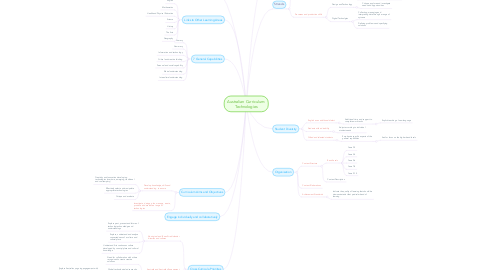
1. Engage individually and collaboratively
2. Curriculum Aims and Objectives
2.1. Develop knowledge, skills and understanding to ensure
2.1.1. Creativity and innovation developing technologies (overtime, emerging, traditional and comtempory)
2.1.2. Effectively select and manipulate appropriate technologies
2.1.3. Critique and evaluate
2.2. Investigate, design, plan, manage, create, produce and evaluate a range of technologies
3. 7 General Capabilities
3.1. Literacy
3.2. Numeracy
3.3. Information and technology
3.4. Critical and creative thinking
3.5. Personal and social capability
3.6. Ethical understanding
3.7. Intercultural understanding
4. Cross Curricula Priorities
4.1. Aboriginal and Torres Strait Islander histories and cultures
4.1.1. Explore past, present and future of technologies knowledge and understandings
4.1.2. Explore, understand and analyse connectedness of a culture and culture/place
4.1.3. Understand first continuous culture developed by country/place and cultural knowledge
4.2. Australia and Australias Engagement with Asia
4.2.1. Need for collaboration with others recognized to create creative solutions
4.2.2. Global technological advances by Asian regions explored
4.2.2.1. Explore Australias ongoing engagement with Asia to create products and services to meet needs
4.2.3. Explore traditional, contemporary and emerging technological achievement's within the Asian region
4.3. Sustainability
4.3.1. Consider sustainability when creating solutions ideas and concepts
4.3.1.1. Balance economic, environmental and social impacts
4.3.2. Understanding skills appropriate to technology considering costs and benefits
4.3.3. Identify and create more sustainable patterns for living
5. Links to Other Learning Areas
5.1. English
5.2. Mathematics
5.3. Health and Physical Education
5.4. Science
5.5. History
5.6. The Arts
5.7. Geography
6. ff
7. Organisation
7.1. Content Structure
7.1.1. Band Levels
7.1.1.1. Years F-2
7.1.1.2. Years 3-4
7.1.1.3. Years 5-6
7.1.1.4. Years 7-8
7.1.1.5. Years 9-10
7.1.2. Content Description
7.2. Content Elaborations
7.3. Achievement Standards
7.3.1. Indicate the quality of learning that should be demonstrated at that particular band of learning.
8. Strands
8.1. Knowledge and understanding
8.1.1. Design and Technology
8.1.1.1. Uses and development of technology in peoples lives
8.1.1.1.1. Range of design concepts
8.1.2. Digital Technologies
8.1.2.1. Data representation and structure, symbols and components of hardware, software and networks
8.2. Processes and production skills
8.2.1. Design and Technology
8.2.1.1. Critique, explore and investigate needs and opportunities
8.2.2. Digital Technolgies
8.2.2.1. Collecting, managing and interpreting data through a range of sytsems
8.2.2.2. Defining problems and specifying solutions
9. Key ideas
9.1. Creating preferred futures
9.1.1. Create and actively design solutions to present needs. Focus on not comprising future generations
9.2. Project Management
9.2.1. Students 'self' responsibility for health and safety during design and technology processes
10. Student Diversity
10.1. English as an additional dialect
10.1.1. Additional time and support to complete work tasks
10.1.1.1. Explicit teaching of new language
10.2. Students with a disability
10.2.1. Adjust according to individual student needs
10.3. Gifted and talented students
10.3.1. Emphasise specific aspects of the general capabilities
10.3.1.1. And/or focus on the higher band levels
